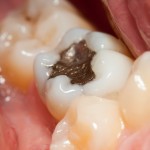
Amalgam has been used for filling teeth for around 150 years. Over that time amalgam restoration have been shown to be a predictable, successful and cost effective. Concerns regarding aesthetics and their mercury content together with improvement in tooth-coloured dental resin cements have seen a decline in their use. Recently the Minamata Convention on Mercury has proposed that the use of dental mercury be phased down by national governments according to local needs.The aim of this Cochrane review was to examine the effects of direct composite resin fillings versus amalgam fillings for permanent posterior teeth, primarily on restoration failure.
Searches were conducted in Cochrane Oral Health Group’s Trials Register the Cochrane Central Register of Controlled Trials (CENTRAL) Medline, Embase, and LILACs with no restrictions. Dental manufacturers were also contacted for any unpublished studies. Randomised controlled trials (RCTs) with follow-up of 3 years were included and standard Cochrane methodological approaches were used.
- 10 articles reporting 7 trials were included. All 7 trials were considered to be at high risk of bias. Two trials were parallel group studies and 5 split mouth studies. Due to reporting issues with the split mouth studies the primary analysis is based on the two parallel group trials involving 1645 composite restorations and 1365 amalgam restorations (921 children). These indicated that resin restorations:-
- had a significantly higher risk of failure than amalgam restorations (risk ratio (RR) 1.89, 95% confidence interval (CI) 1.52 to 2.35, P value < 0.001 (fixed-effect model) (low-quality evidence)) and
- increased risk of secondary caries (RR 2.14, 95% CI 1.67 to 2.74, P value < 0.001 (low-quality evidence))
- but no evidence of an increased risk of restoration fracture (RR 0.87, 95% CI 0.46 to 1.64, P value = 0.66 (moderate-quality evidence).
- Adverse effects of dental restorations were reported in two trials. The outcomes considered were neurobehavioral function, renal function, psychosocial function, and physical development. The investigators found no difference in adverse effects between composite and amalgam restorations. However, the results should be interpreted with caution as none of the outcomes were reported in more than one trial.
The authors concluded
There is low-quality evidence to suggest that resin composites lead to higher failure rates and risk of secondary caries than amalgam restorations. This review reinforces the benefit of amalgam restorations and the results are particularly useful in parts of the world where amalgam is still the material of choice to restore posterior teeth with proximal caries. Though the review found insufficient evidence to support or refute any adverse effects amalgam may have on patients, new research is unlikely to change opinion on its safety and due to the decision for a global phase-down of amalgam (Minamata Convention on Mercury) general opinion on its safety is unlikely to change.
Links
Rasines Alcaraz MG, Veitz-Keenan A, Sahrmann P, Schmidlin PR, Davis D, Iheozor-Ejiofor Z. Direct composite resin fillings versus amalgam fillings for permanent or adult posterior teeth. Cochrane Database of Systematic Reviews 2014, Issue 3. Art. No.: CD005620. DOI: 10.1002/14651858.CD005620.pub2.
Cochrane Oral Health Group – Amalgam filings verses resin composites

“@TheDentalElf: Amalgam still an effective filling material for posterior teeth http://t.co/EH6PPYzcKf”#dentistry
So drilling and filling as normal then!
As the review review discusses in the background section initial interventions for caries should be,
[…] Dental Elf – 7th Apr 2014 – Amalgam still an effective filling material for posterior te… […]
[…] Dental Elf – 7th Apr 2014 – Amalgam still an effective filling material for posterior […]